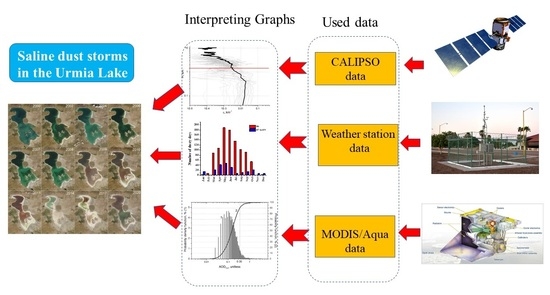Long-Term Investigation of Aerosols in the Urmia Lake Region in the Middle East by Ground-Based and Satellite Data in 2000–2021
Abstract
:1. Introduction
2. Materials and Methods
2.1. Study Area
2.2. Dataset and Methodology
2.2.1. In Situ Data
2.2.2. CALIPSO Aerosol Extinction Coefficient Profiles
2.2.3. Aqua MODIS Aerosol Optical Depth and Ångström Exponent Time Series
3. Results
3.1. Evolution of Dust Events at Some Stations around the Urmia Lake
3.2. Spatial Distribution of MODIS Mean AOD from Aqua Satellite Data
3.3. Tropospheric Aerosol Extinction Coefficient Profiles from CALIPSO Satellite Data
3.4. Variation of Aerosol Optical Depth in the Urmia Lake Region in 2000–2021
3.5. Comparison of AOD According to CALIPSO and Aqua Data
4. Conclusions
Author Contributions
Funding
Data Availability Statement
Acknowledgments
Conflicts of Interest
References
- Tegen, I. Modeling the mineral dust aerosol cycle in the climate system. Quat. Sci. Rev. 2003, 22, 1821–1834. [Google Scholar] [CrossRef]
- Yang, B.; Bräuning, A.; Zhang, Z.; Dong, Z.; Esper, J. Dust storm frequency and its relation to climate changes in Northern China during the past 1000 years. Atmos. Environ. 2007, 41, 9288–9299. [Google Scholar] [CrossRef]
- An, L.; Che, H.; Xue, M.; Zhang, T.; Wang, H.; Wang, Y.; Zhou, C.; Zhao, H.; Gui, K.; Zheng, Y.; et al. Temporal and spatial variations in sand and dust storm events in East Asia from 2007 to 2016: Relationships with surface conditions and climate change. Sci. Total Environ. 2018, 633, 452–462. [Google Scholar] [CrossRef] [PubMed]
- Salehi, S.; Ardalan, A.; Ostadtaghizadeh, A.; Garmaroudi, G.; Zareiyan, A.; Rahimiforoushani, A. Conceptual definition and framework of climate change and dust storm adaptation: A qualitative study. J. Environ. Sci. Health Part A 2019, 17, 797–810. [Google Scholar] [CrossRef] [PubMed]
- Schepanski, K. Transport of mineral dust and ist impact on climate. Geosciences 2018, 8, 151. [Google Scholar] [CrossRef]
- Paytan, A.; Mackey, K.R.M.; Chen, Y.; Lima, I.D.; Doney, S.C.; Mahowald, N.; Labiosa, R.; Post, A.F. Toxicity of atmospheric aerosols on marine phytoplankton. Proc. Natl. Acad. Sci. USA 2009, 106, 4601–4605. [Google Scholar] [CrossRef] [PubMed]
- Bali, K.; Mishra, A.K.; Singh, S.; Chandra, S.; Lehahn, Y. Impact of dust storm on phytoplankton bloom over the Arabian Sea: A case study during March 2012. Environ. Sci. Poll. Res. 2019, 26, 11940–11950. [Google Scholar] [CrossRef] [PubMed]
- Gassó, S.; Grassian, V.H.; Miller, R.I. Interaction between mineral dust, climate, and ocean ecosystems. Elements 2010, 6, 247–252. [Google Scholar] [CrossRef]
- Kutuzov, S.; Mikhalenko, V.; Toropov, P.; Legrand, M.; Preunkert, S.; Ginot, P.; Shukurov, K.; Poliukhov, A. The Elbrus (Caucasus, Russia) ice core record-Part 2: History of desert dust deposition. Atmos. Chem. Phys. 2019, 19, 14133–14148. [Google Scholar] [CrossRef]
- Ghosh, T.; Pal, I. Dust storm and its environmental implications. J. Eng. Comput. Appl. Sci. 2014, 3, 30–37. [Google Scholar]
- Naji, H.; Taherpour, M. The effect of simulated dust storm on wood development and leaf stomata in Quercus brantii L. Desert 2019, 24, 43–49. [Google Scholar]
- Griffin, D.W.; Kellogg, C.A. Dust storms and their impact on ocean and human health: Dust in Earth’s atmosphere. EcoHealth 2004, 1, 284–295. [Google Scholar] [CrossRef]
- Hashizume, M.; Ueda, K.; Nishiwaki, Y.; Michikawa, T.; Onozuka, D. Health effects of Asian dust events: A review of the literature. Nihon Eiseigaku Zasshi. Jpn. J. Hygiene 2010, 65, 413–421. [Google Scholar] [CrossRef]
- Yu, H.L.; Chien, L.C.; Yang, C.H. Asian dust storm elevates children’s respiratory health risks: A spatiotemporal analysis of children’s clinic visits across Taipei (Taiwan). PLoS ONE 2012, 7, e41317. [Google Scholar] [CrossRef]
- Ardon-Dryer, K.; Mock, C.; Reyes, J.; Lahav, G. The effect of dust storm particles on single human lung cancer cells. Environ. Res. 2020, 181, 108891–108910. [Google Scholar] [CrossRef]
- Opp, C.; Groll, M.; Abbasi, H.; Foroushani, M.A. Causes and effects of sand and dust storms: What has past research taught us? A survey. J. Risk. Finan. Mang. 2021, 14, 326. [Google Scholar] [CrossRef]
- Li, J.; Garshick, E.; Huang, S.; Koutrakis, P. Impacts of El Niño-Southern Oscillation on surface dust levels across the world during 1982–2019. Sci. Total Environ. 2021, 769, 144566. [Google Scholar] [CrossRef]
- Labban, A.H.; Butt, M.J. Analysis of sand and dust storm events over Saudi Arabia in relation with meteorological parameters and ENSO. Arab. J. Geosci. 2021, 14, 22. [Google Scholar] [CrossRef]
- Okin, G.S.; Reheis, M.C. An ENSO predictor of dust emission in the southwestern United States. Geophys. Res. Lett. 2002, 29, 46–49. [Google Scholar] [CrossRef]
- Hara, Y.; Uno, I.; Wang, Z. Long-term variation of Asian dust and related climate factors. Atmos. Environ. 2006, 40, 6730–6740. [Google Scholar] [CrossRef]
- Engelstaedter, S.; Kohfeld, K.E.; Tegen, I.; Harrison, S.P. Controls of dust emissions by vegetation and topographic depressions: An evaluation using dust storm frequency data. Geophys. Res. Lett. 2003, 30, 1294–1297. [Google Scholar] [CrossRef]
- Kimura, R.; Bai, L.; Wang, J. Relationships among dust outbreaks, vegetation cover, and surface soil water content on the Loess Plateau of China, 1999–2000. Catena 2009, 77, 292–296. [Google Scholar] [CrossRef]
- Khusfi, Z.E.; Khosroshahi, M.; Roustaei, F.; Mirakbari, M. Spatial and seasonal variations of sand-dust events and their relation to atmospheric conditions and vegetation cover in semi-arid regions of central Iran. Geoderma 2020, 365, 114225. [Google Scholar] [CrossRef]
- Hamzeh, N.H.; Karami, S. Investigation of a Severe Dust Storm over the Aral Sea Area; MegaPrint Inc.: Holderness, NH, USA, 2017. [Google Scholar]
- Xu, X.; Levy, J.K.; Zhaohui, L.; Hong, C. An investigation of sand–dust storm events and land surface characteristics in China using NOAA NDVI data. Glob. Planet. Change 2006, 52, 182–196. [Google Scholar] [CrossRef]
- Boloorani, A.D.; Nabavi, S.O.; Azizi, R.; Bahrami, H.A. Characterization of dust storm sources in western Iran using a synthetic approach. In Advances in Meteorology, Climatology and Atmospheric Physics; Springer: Berlin/Heidelberg, Germany, 2013; pp. 415–420. [Google Scholar]
- Liu, X.; Yin, Z.Y.; Zhang, X.; Yang, X. Analyses of the spring dust storm frequency of northern China in relation to antecedent and concurrent wind, precipitation, vegetation, and soil moisture conditions. J. Geophys. Res. Atmos. 2004, 109, 16210–16226. [Google Scholar] [CrossRef]
- Farahat, A.; El-Askary, H.; Dogan, A.U. Aerosols size distribution characteristics and role of precipitation during dust storm formation over Saudi Arabia. Aerosol Air Qual. Res. 2016, 16, 2523–2534. [Google Scholar] [CrossRef]
- Dar, M.A.; Ahmed, R.; Latif, M.; Azam, M. Climatology of dust storm frequency and its association with temperature and precipitation patterns over Pakistan. Nat. Hazards 2022, 110, 655–677. [Google Scholar] [CrossRef]
- Opp, C.; Groll, M.; Aslanov, I.; Lotz, T.; Vereshagina, N. Aeolian dust deposition in the Southern Aral Sea region (Uzbekistan)—Ground-based monitoring results from the LUCA project. Quat. Int. 2016, 429, 86–99. [Google Scholar] [CrossRef]
- Goudie, A.S.; Middleton, N.J. Desert Dust in the Global System; Springer Science & Business Media: Berlin, Germany, 2006. [Google Scholar]
- Shao, Y.; Wyrwoll, K.-H.; Chappell, A.; Huang, J.; Lin, Z.H.; McTainsh, G.H.; Mikami, M.; Tanaka, T.Y.; Wang, X.; Yoon, S. Dust cyle: An emerging core theme in Earthsystem science. Aeo. Res. 2011, 2, 181–204. [Google Scholar] [CrossRef]
- Middleton, N.J. Desert dust hazards: A global review. Aeo. Res. 2017, 24, 53–63. [Google Scholar] [CrossRef]
- Micklin, P. The Aral Sea disaster. Annu. Rev. Earth Planet. Sci. 2007, 35, 47–72. [Google Scholar] [CrossRef]
- Opp, C.; Wagemann, J.; Banedjshafi, S.; Abbasi, H.R. Aral Sea Syndrome and Lake Urmia crisis. A Comparison of causes, effects and strategies for problem solutions. In Geoparks and Geotourism in Iran. Schriften zur Internationalen Entwicklungs-und Umweltforschung; Dittmann, A., Ed.; Zentrum für Internationale Entwicklungs-und Umweltforschung; Universität Gießen: Giessen, Germany, 2017; Volume 34, pp. 169–183. [Google Scholar]
- Issanova, G.; Abuduwaili, J.; Galayeva, O.; Semenov, O.; Bazarbayeva, T. Aeolian transportation of sand and dust in the Aral Sea region. Int. J. Environ. Sci. Technol. 2015, 12, 3213–3224. [Google Scholar] [CrossRef]
- Huang, X.; Oberhänsli, H.; von Suchodoletz, H.; Sorrel, P. Dust deposition in the Aral Sea: Implications for changes in atmospheric circulation in central Asia during the past 2000 years. Quat. Sci. Rev. 2011, 30, 3661–3674. [Google Scholar] [CrossRef]
- Karami, S.; Hamzeh, N.H.; Kaskaoutis, D.G.; Rashki, A.; Alam, K.; Ranjbar, A. Numerical simulations of dust storms originated from dried lakes in central and southwest Asia: The case of Aral Sea and Sistan Basin. Aeo. Res. 2021, 50, 100679. [Google Scholar] [CrossRef]
- Rashki, A.; Eriksson, P.G.; Rautenbach, C.D.W.; Kaskaoutis, D.G.; Grote, W.; Dykstra, J. Assessment of chemical and mineralogical characteristics of airborne dust in the Sistan region, Iran. Chemosphere 2013, 90, 227–236. [Google Scholar] [CrossRef] [PubMed]
- Miri, A.; Maleki, S.; Middleton, N. An investigation into climatic and terrestrial drivers of dust storms in the Sistan region of Iran in the early twenty-first century. Sci. Total Environ. 2021, 757, 143952. [Google Scholar] [CrossRef] [PubMed]
- Gholampour, A.; Nabizadeh, R.; Hassanvand, M.S.; Taghipour, H.; Nazmara, S.; Mahvi, A.H. Characterization of saline dust emission resulted from Urmia Lake drying. J. Environ. Sci. Health Eng. 2015, 13, 82. [Google Scholar] [CrossRef]
- Mardi, A.H.; Khaghani, A.; MacDonald, A.B.; Nguyen, P.; Karimi, N.; Heidary, P.; Karimi, N.; Saemian, P.; Sehatkashani, S.; Tajrishy, M.; et al. The Lake Urmia environmental disaster in Iran: A look at aerosol pollution. Sci. Total Environ. 2018, 633, 42–49. [Google Scholar] [CrossRef]
- Boroughani, M.; Hashemi, H.; Hosseini, S.H.; Pourhashemi, S.; Berndtsson, R. Desiccating Lake Urmia: A new dust source of regional importance. IEEE Geosci. Remote Sens. Lett. 2019, 17, 1483–1487. [Google Scholar] [CrossRef]
- Hamzeh, N.H.; Ranjbar, A.S.; Gee, M.O.; Habibi, M.; Schöner, W. Analyses of a Lake Dust Source in the Middle East through Models Performance. Remote Sens. 2022, 50, 100679. [Google Scholar] [CrossRef]
- Abuduwaili, J.; DongWei, L.I.U.; GuangYang, W.U. Saline dust storms and their ecological impacts in arid regions. J. Arid. Land 2010, 2, 144–150. [Google Scholar] [CrossRef]
- Liu, D.; Abuduwaili, J.; Lei, J.; Wu, G. Deposition rate and chemical composition of the aeolian dust from a bare saline playa, Ebinur Lake, Xinjiang, China. Water Air Soil Pollut. 2011, 218, 175–184. [Google Scholar] [CrossRef]
- Ghale, Y.A.G.; Altunkaynak, A.; Unal, A. Investigation anthropogenic impacts and climate factors on drying up of Urmia Lake using water budget and drought analysis. Water Resour. Manag. 2018, 32, 325–337. [Google Scholar] [CrossRef]
- Delju, A.H.; Ceylan, A.; Piguet, E.; Rebetez, M. Observed climate variability and change in Urmia Lake Basin, Iran. Theor. Appl. Clim. 2013, 111, 285–296. [Google Scholar] [CrossRef]
- Ahmady-Birgani, H.; Ravan, P.; Schlosser, J.S.; Cuevas-Robles, A.; AzadiAghdam, M.; Sorooshian, A. On the chemical nature of wet deposition over a major desiccated lake: Case study for Lake Urmia basin. Atmos. Res. 2020, 234, 104762–104774. [Google Scholar] [CrossRef]
- Hassanzadeh, E.; Zarghami, M.; Hassanzadeh, Y. Determining the main factors in declining the Urmia Lake level by using system dynamics modeling. Water Res. Manag. 2012, 26, 129–145. [Google Scholar] [CrossRef]
- Singer, A.R.I.E.H.; Zobeck, T.; Poberezsky, L.; Argaman, E. The PM10and PM2· 5 dust generation potential of soils/sediments in the Southern Aral Sea Basin, Uzbekistan. J. Arid Environ. 2003, 54, 705–728. [Google Scholar] [CrossRef]
- Indoitu, R.; Kozhoridze, G.; Batyrbaeva, M.; Vitkovskaya, I.; Orlovsky, N.; Blumberg, D.; Orlovsky, L. Dust emission and environmental changes in the dried bottom of the Aral Sea. Aeolian Res. 2015, 17, 101–115. [Google Scholar] [CrossRef]
- Kochkarova, S.; Mambetullaeva, S. Study of Successional Processes of Vegetation Cover on the Dried Seabed of the Aral Sea. J. Res. Lepid. 2020, 51, 764–768. [Google Scholar] [CrossRef]
- Dukhovny, V.A.; de Schutter, J. Water in Central Asia: Past, Present, Future; CRC Press: Boca Raton, FL, USA, 2011. [Google Scholar]
- Soudi, M.; Ahmadi, H.; Yasi, M.; Hamidi, S.A. Sustainable restoration of the Urmia Lake: History, threats, opportunities and challenges. In Eur. Water; 2017; 60, pp. 341–347. Available online: https://worldview.earthdata.nasa.gov (accessed on 8 July 2022).
- Gholampour, A.; Nabizadeh, R.; Naseri, S.; Yunesian, M.; Taghipour, H.; Rastkari, N.; Nazmara, S.; Faridi, S.; Mahvi, A.H. Exposure and health impacts of outdoor particulate matter in two urban and industrialized area of Tabriz, Iran. J. Environ. Health Sci. Eng. 2014, 12, 27. [Google Scholar] [CrossRef]
- Delfi, S.; Mosaferi, M.; Hassanvand, M.S.; Maleki, S. Investigation of aerosols pollution across the eastern basin of Urmia lake using satellite remote sensing data and HYSPLIT model. J. Environ. Sci. Health Sci. Eng. 2019, 17, 1107–1120. [Google Scholar] [CrossRef] [PubMed]
- Harati, H.; Kiadaliri, M.; Tavana, A.; Rahnavard, A.; Amirnezhad, R. Urmia Lake dust storms occurrences: Investigating the relationships with changes in water zone and land cover in the eastern part using remote sensing and GIS. Environ. Monit. Assess. 2021, 193, 70. [Google Scholar] [CrossRef] [PubMed]
- Habibi, M.; Babaeian, I.; Schöner, W. Changing Causes of Drought in the Urmia Lake Basin—Increasing Influence of Evaporation and Disappearing Snow Cover. Water 2021, 13, 3273. [Google Scholar] [CrossRef]
- Hamzeh, N.H.; Karami, S.; Opp, C.; Fattahi, E.; Jean-François, V. Spatial and temporal variability in dust storms in the Middle East, 2002–2018: Three case studies in July 2009. Arab. J. Geosci. 2021, 14, 538. [Google Scholar] [CrossRef]
- Karami, S.; Hamzeh, N.H.; Abadi, A.R.S.; Madhavan, B.L. Investigation of a severe frontal dust storm over the Persian Gulf in February 2020 by CAMS model. Arab. J. Geosci. 2021, 14, 2041. [Google Scholar] [CrossRef]
- Hamzeh, N.H.; Kaskaoutis, D.G.; Rashki, A.; Mohammadpour, K. Long-Term Variability of Dust Events in Southwestern Iran and Its Relationship with the Drought. Atmosphere 2021, 12, 1350. [Google Scholar] [CrossRef]
- Notaro, M.; Yu, Y.; Kalashnikova, O.V. Regime shift in Arabian dust activity, triggered by persistent Fertile Crescent drought. J. Geophys. Res. Atmos. 2015, 120, 10–229. [Google Scholar] [CrossRef]
- Available online: https://www-calipso.larc.nasa.gov (accessed on 24 June 2022).
- Ghasem, A.; Shamsipour, A.; Miri, M.; Safarrad, T. Synoptic and remote sensing analysis of dust events in southwestern Iran. Nat. Hazards 2012, 64, 1625–1638. [Google Scholar] [CrossRef]
- Barlow, M.; Zaitchik, B.; Paz, S.; Black, E.; Evans, J.; Hoell, A. A review of drought in the Middle East and southwest Asia. J. Clim. 2016, 29, 8547–8574. [Google Scholar] [CrossRef]
- Tabari, H.; Nikbakht, J.; Talaee, P.H. Hydrological drought assessment in Northwestern Iran based on streamflow drought index (SDI). Water Res. Manag. 2013, 27, 137–151. [Google Scholar] [CrossRef]
- Shukurov, K.A.; Shukurova, L.M. The fields of mean concentration in potential sources of ammonium sulphate, ammonium nitrate and natural silicates for the west of Moscow region. In Proceedings of the 23rd International Symposium on Atmospheric and Ocean Optics: Atmospheric Physics, Irkutsk, Russian, 3–7 July 2017; Volume 10466, p. 104663U. [Google Scholar] [CrossRef]
- Zachary, M.; Lun, Y.; Mwai, Z. Application of PSCF and CWT to Identify Potential Sources of Aerosol Optical Depth in ICIPE Mbita. Open Access Libr. J. 2018, 5, 1–12. [Google Scholar] [CrossRef]
- Dimitriou, K. The Dependence of PM Size Distribution from Meteorology and Local-Regional Contributions, in Valencia (Spain)–A CWT Model Approach. Aerosol Air Qual. Res. 2015, 15, 1979–1989. [Google Scholar] [CrossRef]
- Li, C.; Dai, Z.; Liu, X.; Wu, P. Transport Pathways and Potential Source Region Contributions of PM2.5 in Weifang: SeasonalVariations. Appl. Sci. 2020, 10, 2835. [Google Scholar] [CrossRef]
- Shukurov, K.A.; Shukurova, L.M. An influence of transboundary transport to aerosols of South of Russian Far East by data of AERONET Ussuriysk site, Russia. In Proceedings of the 24th International Symposium on Atmospheric and Ocean Optics: Atmospheric Physics, Tomsk, Russian, 2–5 July 2018; Volume 10833, p. 108337F. [Google Scholar] [CrossRef]
- Shukurov, K.A.; Shukurova, L.M. Potential sources of Southern Siberia aerosols by data of AERONET site in Tomsk, Russia. In Proceedings of the 23rd International Symposium on Atmospheric and Ocean Optics: Atmospheric Physics, Irkutsk, Russian, 3–7 July 2017; Volume 10466, p. 104663W. [Google Scholar] [CrossRef]
- Shukurov, K.A.; Chkhetiani, O.G. Probability of transport of air parcels from the arid lands in the Southern Russia to Moscow region. In Proceedings of the 23rd International Symposium on Atmospheric and Ocean Optics: Atmospheric Physics, Irkutsk, Russian, 3–7 July 2017; Volume 10466, p. 104663V. [Google Scholar] [CrossRef]
- Kaskaoutis, D.G.; Kambezidis, H.D.; Nastos, P.T.; Kosmopoulos, P.G. Study on an intense dust storm over Greece. Atmos. Environ. 2008, 42, 6884–6896. [Google Scholar] [CrossRef]
- Karami, S.; Hamzeh, N.H.; Alam, K.; Noori, F.; Abadi, A.R.S. Spatio-temporal and synoptic changes in dust at the three islands in the Persian Gulf region. J. Atmos. Sol. Terr. Phys. 2021, 214, 105539. [Google Scholar] [CrossRef]
- Hamzeh, N.H.; Karami, S.; Kaskaoutis, D.G.; Tegen, I.; Moradi, M.; Opp, C. Atmospheric dynamics and numerical simulations of six frontal dust storms in the Middle East region. Atmosphere 2021, 12, 125. [Google Scholar] [CrossRef]
- Zoljoodi, M.; Didevarasl, A.; Saadatabadi, A.R. Dust events in the western parts of Iran and the relationship with drought expansion over the dust-source areas in Iraq and Syria. Atmos. Clim. Sci. 2013, 3, 321–336. [Google Scholar] [CrossRef]
- Ginoux, P.; Garbuzov, D.; Hsu, N.C. Identification of anthropogenic and natural dust sources using moderate resolution imaging spectroradiometer (MODIS) deep blue level 2 data. J. Geophys. Res. 2010, 115, D05204. [Google Scholar] [CrossRef]
- Nobakht, M.; Shahgedanova, M.; White, K. New inventory of dust emission sources in Central Asia and northwestern China derived from MODIS imagery using dust enhancement technique. J. Geophys. Res. Atmos. 2021, 126, e2020JD033382. [Google Scholar] [CrossRef]
- Fiedler, S.; Schepanski, K.; Heinold, B.; Knippertz, P.; Tegen, I. Climatology of nocturnal low-level jets over North Africa and implications for modeling mineral dust emission. J. Geophys. Res. Atmos. 2013, 118, 6100–6121. [Google Scholar] [CrossRef]
- Caponi, L.; Formenti, P.; Massabó, D.; Di Biagio, C.; Cazaunau, M.; Pangui, E.; Chevaillier, S.; Landrot, G.; Andreae, M.O.; Kandler, K.; et al. Spectral-and size-resolved mass absorption efficiency of mineral dust aerosols in the shortwave spectrum: A simulation chamber study. J. Geophys. Res. Atmos. 2017, 17, 7175–7191. [Google Scholar] [CrossRef]
- Bangalath, H.K.; Stenchikov, G. Sensitivity of the Middle East–North African Tropical Rainbelt to Dust Shortwave Absorption: A High-Resolution AGCM Experiment. J. Clim. 2016, 29, 7103–7126. [Google Scholar] [CrossRef]
- Sicard, M.; Bertolín, S.; Mallet, M.; Dubuisson, P.; Comerón, A. Estimation of mineral dust long-wave radiative forcing: Sensitivity study to particle properties and application to real cases in the region of Barcelona. Atmos. Chem. Phys. 2014, 14, 9213–9231. [Google Scholar] [CrossRef]
- Haywood, J.M.; Allan, R.P.; Culverwell, I.; Slingo, T.; Milton, S.; Edwards, J.; Clerbaux, N. Can desert dust explain the outgoing longwave radiation anomaly over the Sahara during July 2003. J. Geophys. Res. Atmos. 2005, 110, D05105.1–D05105.14. [Google Scholar] [CrossRef]
- Yin, Y.; Wurzler, S.; Levin, Z.; Reisin, T.G. Interactions of mineral dust particles and clouds: Effects on precipitation and cloud optical properties. J. Geophys. Res. Atmos. 2002, 107, 10–19. [Google Scholar] [CrossRef]
- Ebrahimi-Khusfi, Z.; Mirakbari, M.; Khosroshahi, M. Vegetation response to changes in temperature, rainfall, and dust in arid environments. Environ. Monitor. Assess. 2020, 192, 691. [Google Scholar] [CrossRef]
- Soleimani Sardoo, F.; Hosein Hamzeh, N.; Karami, S.; Nateghi, S.; Hashemi Nezhad, M. Emission and transport of dust particles in Jazmourian basin (Case study: Dust storm 24 to 26 November 2016). J. Clim. Res. 2022, 1400, 41–54. [Google Scholar]
- Creamean, J.M.; Suski, K.J.; Rosenfeld, D.; Cazorla, A.; DeMott, P.J.; Sullivan, R.C.; White, A.B.; Ralph, F.M.; Minnis, P.; Comstock, J.M.; et al. Dust and biological aerosols from the Sahara and Asia influence precipitation in the western US. Science 2013, 339, 1572–1578. [Google Scholar] [CrossRef]
- Pi, H.; Sharratt, B.; Lei, J. Atmospheric dust events in central Asia: Relationship to wind, soil type, and land use. J. Geophys. Res. Atmos. 2017, 122, 6652–6671. [Google Scholar] [CrossRef]
- Farahmand, N.; Sadeghi, V. Estimating soil salinity in the dried lake bed of Urmia Lake using optical Sentinel-2 images and nonlinear regression models. J. Indian Soc. Remote Sens. 2020, 48, 675–687. [Google Scholar] [CrossRef]
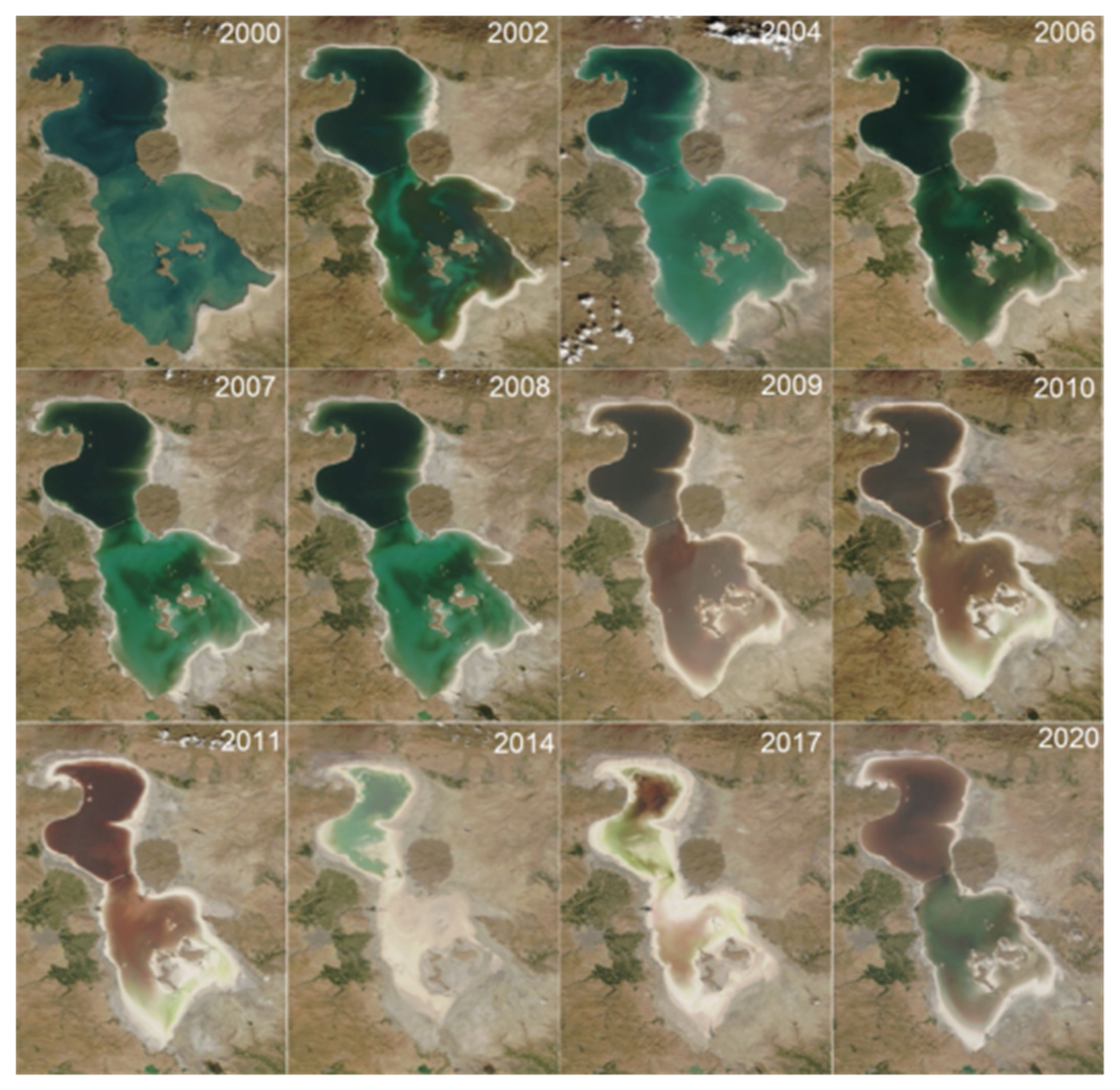
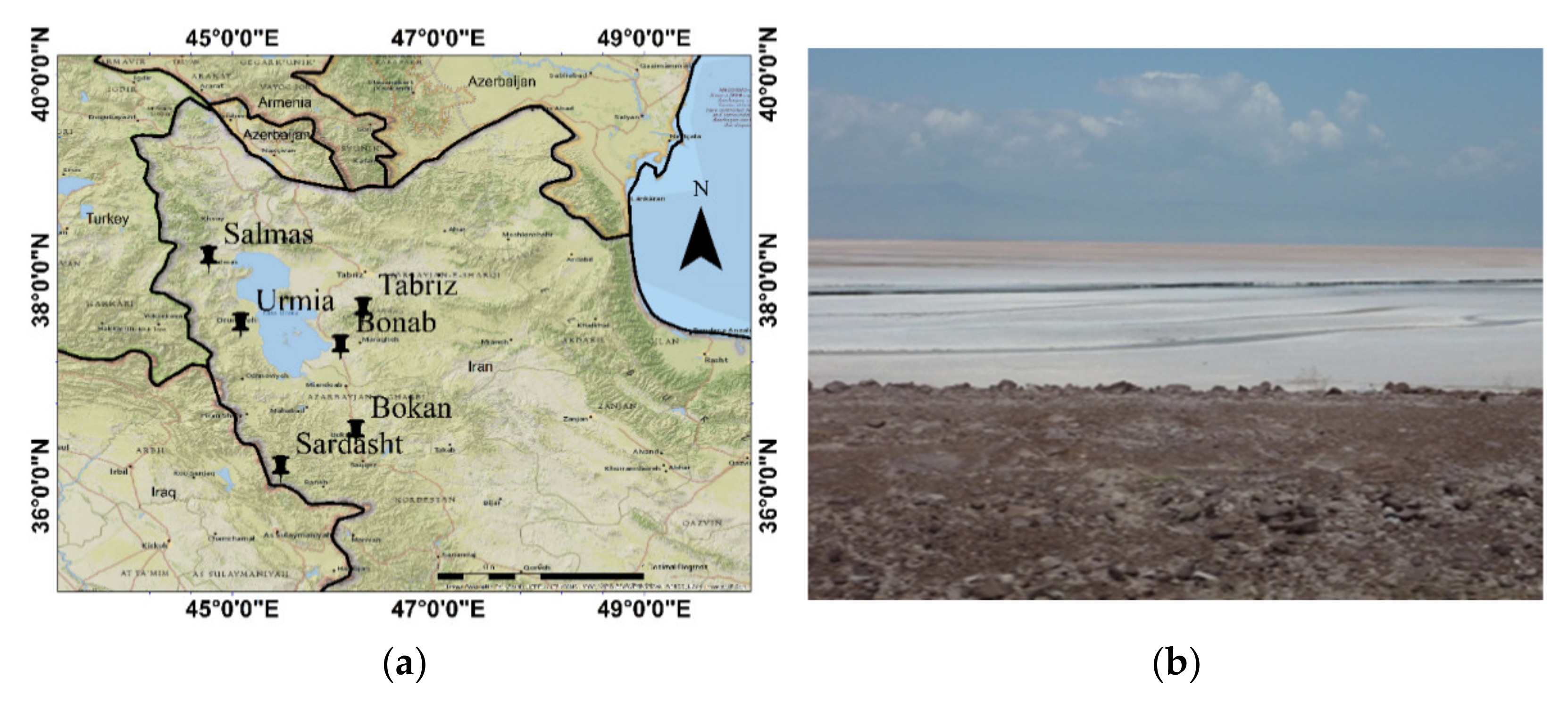
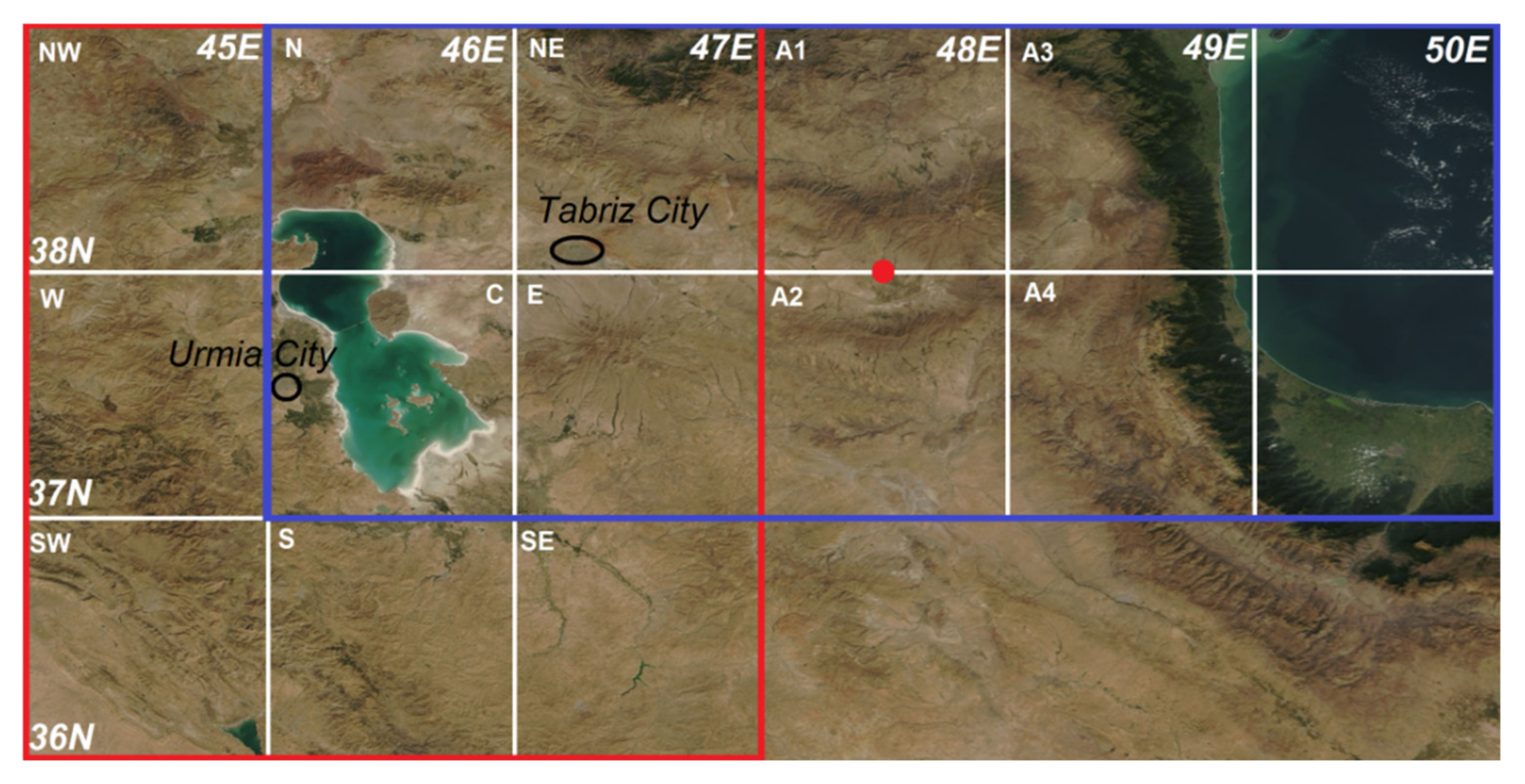

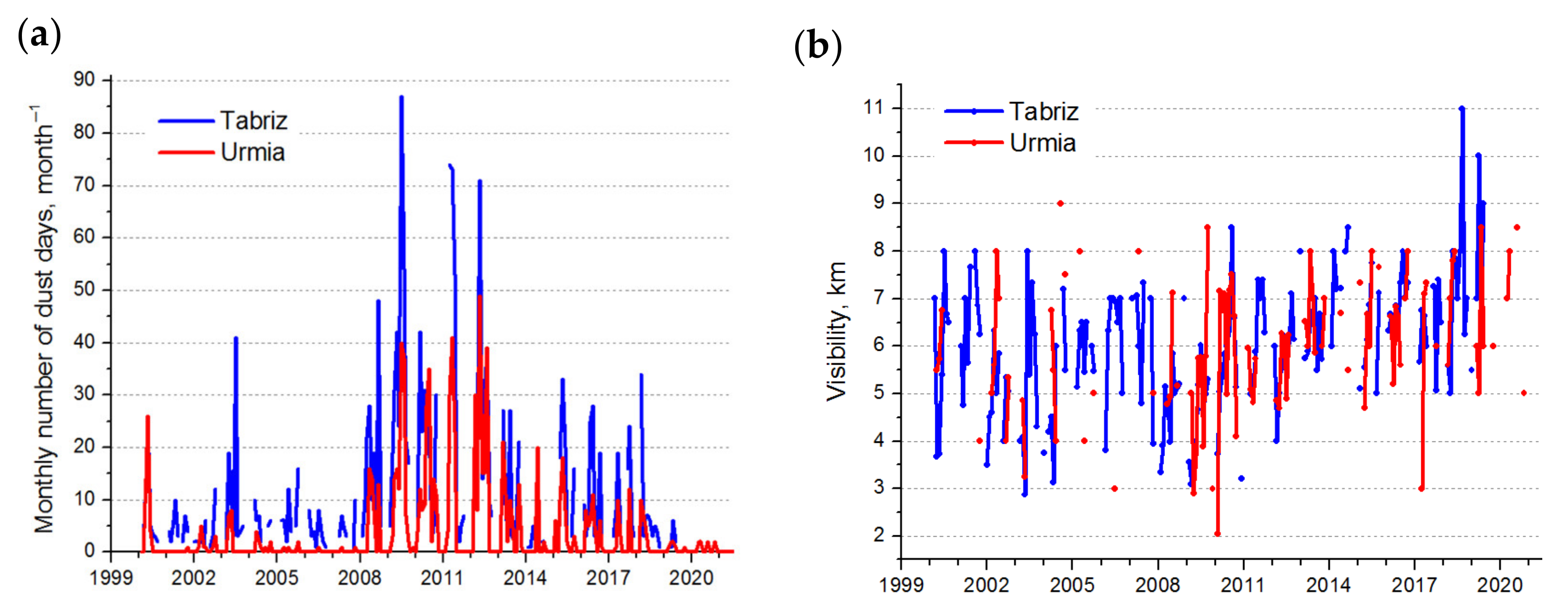
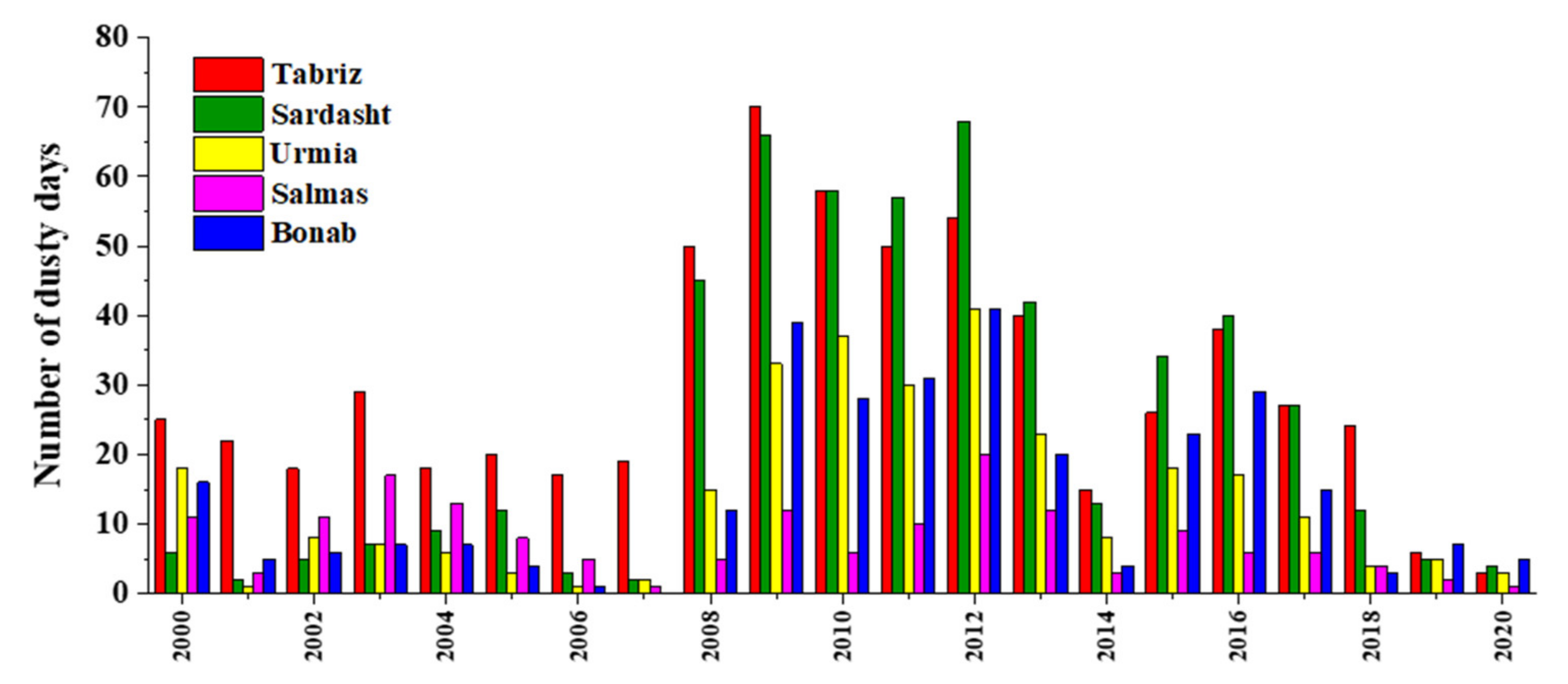
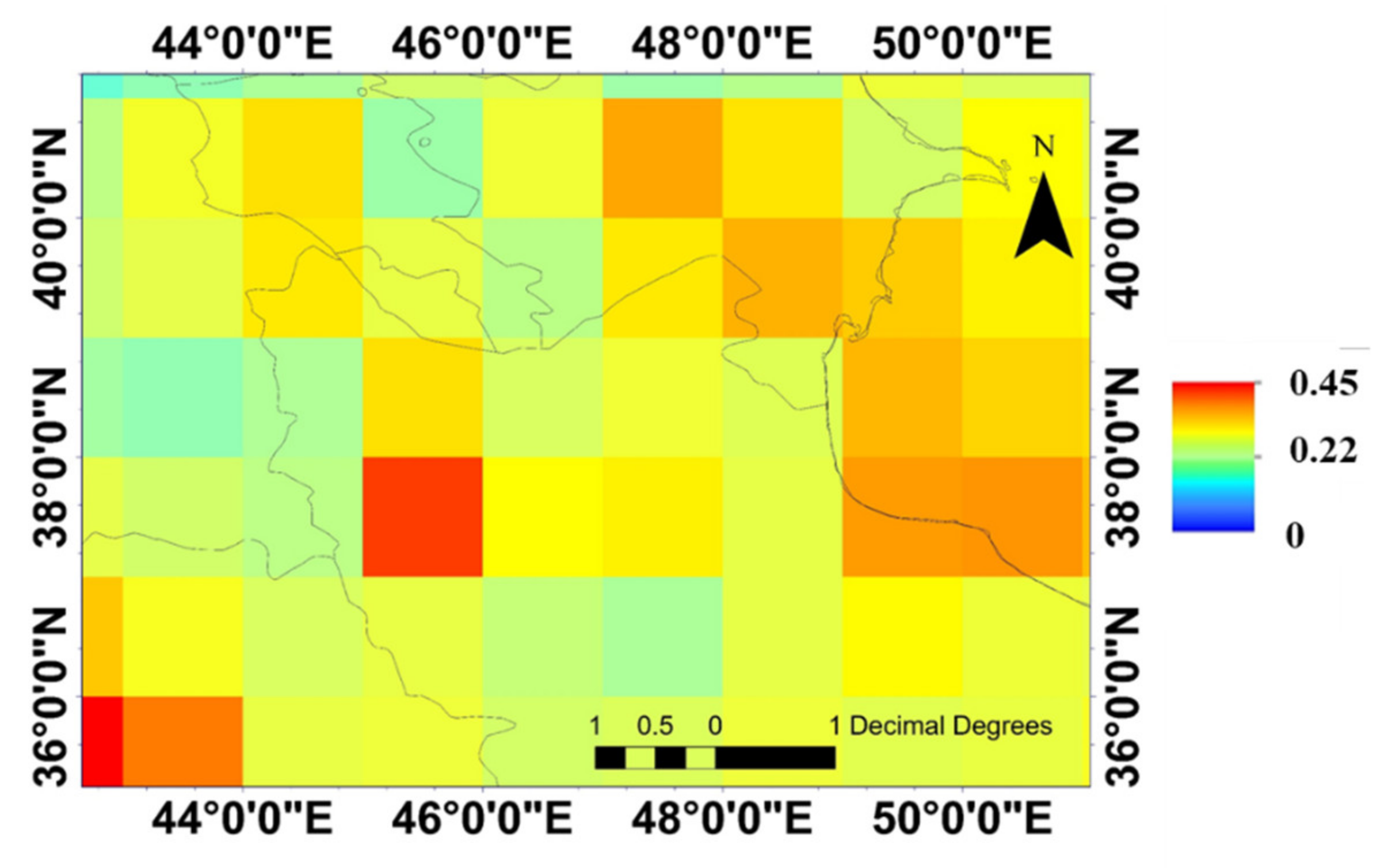
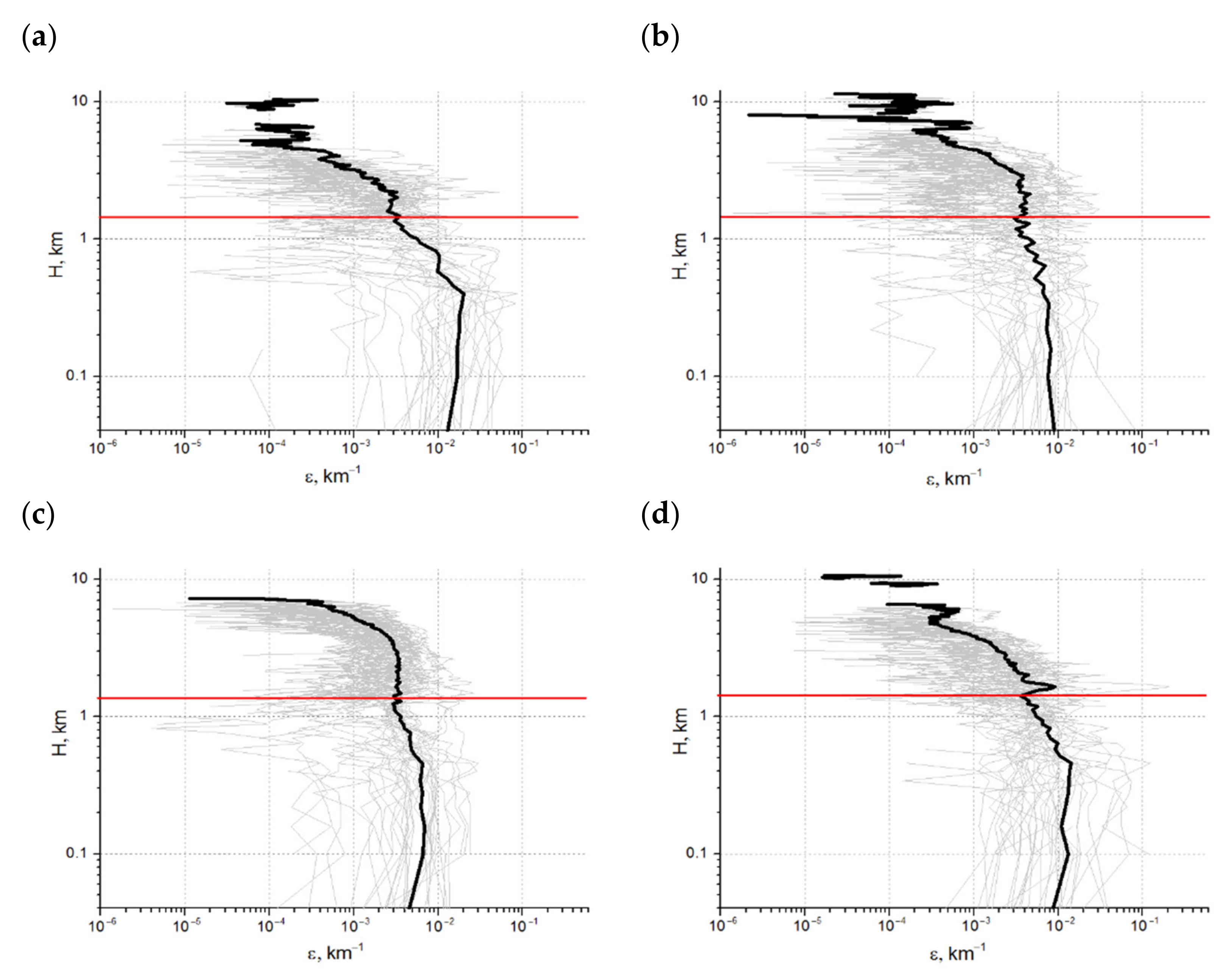
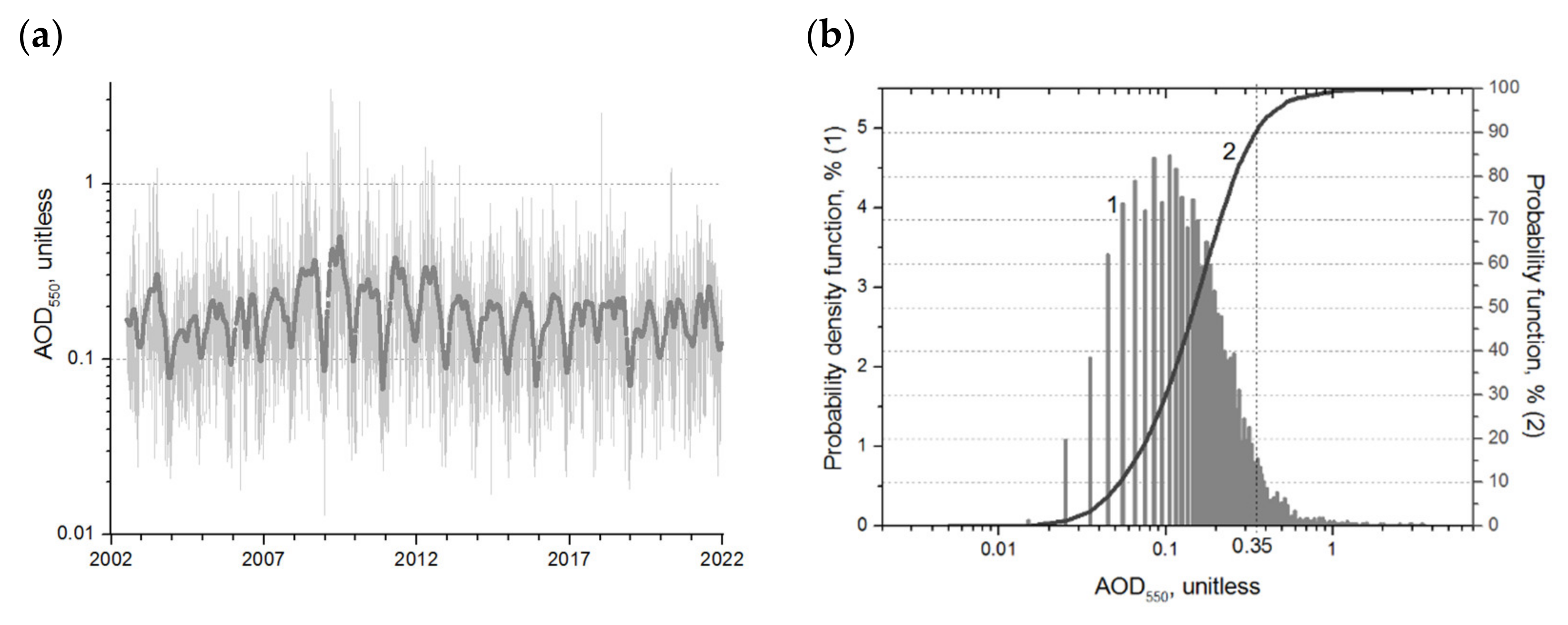
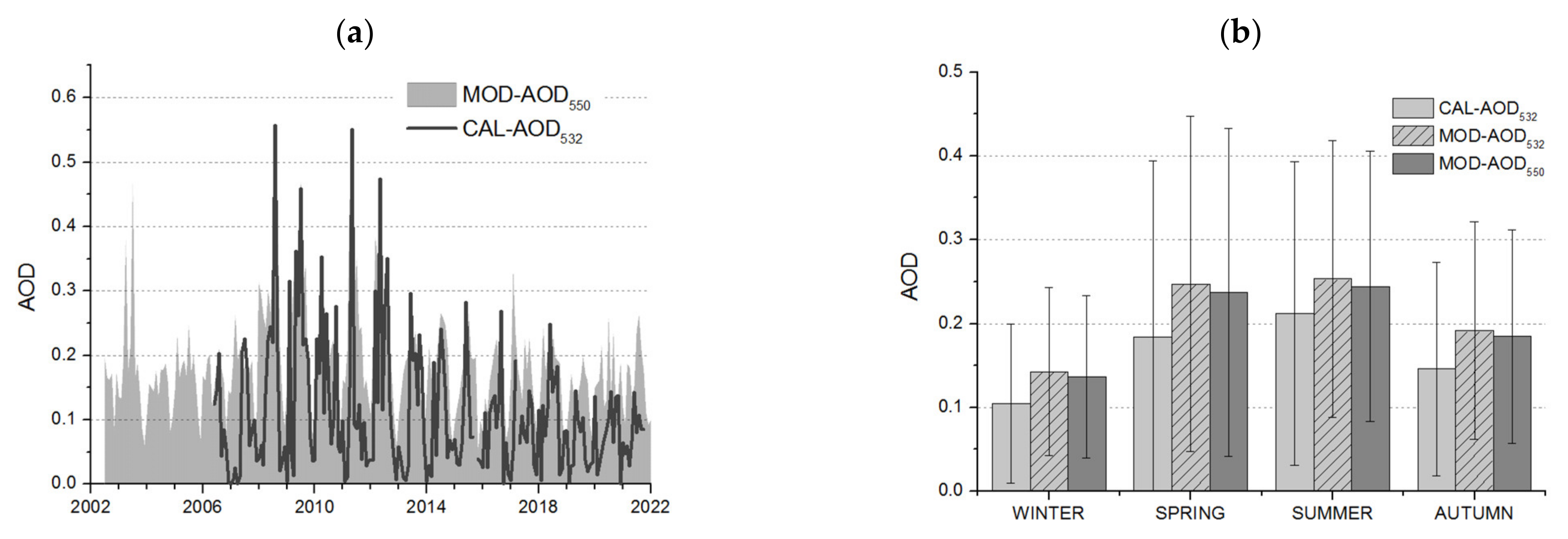
| 06 | Widespread dust in suspension, not raised by wind at or near the station at the time of observation |
| 07 | Dust or sand raised by wind at or near the station at the time of observation |
| 08 | Well-developed dust whirl(s) or sand whirl(s) seen at or near the station during the preceding hour or at the time of observation, but no dust storm or sandstorm |
| 09 | Dust storm or sandstorm within sight at the time of observation, or the station during the preceding hour |
| 30–32 | Slight or moderate sandstorms or dust storms |
| 33–35 | Severe sandstorms or dust storms |
| Synoptic Station | Longitude | Latitude | Elevation | Mean Number of Dust Days |
|---|---|---|---|---|
| Urmia | 45.08 | 37.55 | 1328 | 21.67 |
| Tabriz | 46.27 | 35.7 | 1361 | 57.82 |
| Winter | Spring | Summer | Autumn | Year | |
|---|---|---|---|---|---|
| NW | 0.29 (0.14) | 0.33 (0.18) | 0.31 (0.18) | 0.24 (0.13) | 0.29 (0.16) |
| W | 0.22 (0.11) | 0.39 (0.21) | 0.37 (0.20) | 0.26 (0.13) | 0.31 (0.16) |
| SW | 0.17 (0.10) | 0.42 (0.23) | 0.37 (0.22) | 0.29 (0.16) | 0.31 (0.18) |
| SS | 0.17 (0.10) | 0.39 (0.20) | 0.40 (0.23) | 0.31 (0.16) | 0.32 (0.17) |
| SE | 0.19 (0.10) | 0.32 (0.18) | 0.44 (0.22) | 0.32 (0.14) | 0.32 (0.16) |
| EE | 0.26 (0.13) | 0.46 (0.19) | 0.60 (0.26) | 0.40 (0.17) | 0.43 (0.16) |
| NE | 0.27 (0.14) | 0.44 (0.22) | 0.42 (0.23) | 0.34 (0.17) | 0.37 (0.19) |
| All | 0.22 (0.12) | 0.39 (0.20) | 0.42 (0.22) | 0.31 (0.15) | 0.34 (0.17) |
| W | NW | S | SE | E | NE | A2 | A1 | A4 | A3 | |
|---|---|---|---|---|---|---|---|---|---|---|
| SW | 0.75 | 0.54 | 0.82 | 0.63 | 0.59 | 0.48 | 0.50 | 0.46 | 0.46 | 0.42 |
| W | 0.77 | 0.80 | 0.75 | 0.75 | 0.65 | 0.61 | 0.52 | 0.52 | 0.47 | |
| NW | 0.59 | 0.64 | 0.70 | 0.70 | 0.59 | 0.57 | 0.51 | 0.50 | ||
| S | 0.82 | 0.77 | 0.60 | 0.66 | 0.57 | 0.61 | 0.51 | |||
| SE | 0.87 | 0.68 | 0.83 | 0.66 | 0.71 | 0.60 | ||||
| E | 0.81 | 0.84 | 0.72 | 0.70 | 0.63 | |||||
| NE | 0.73 | 0.83 | 0.70 | 0.74 | ||||||
| A2 | 0.73 | 0.81 | 0.69 | |||||||
| A1 | 0.80 | 0.87 | ||||||||
| A4 | 0.79 |
Publisher’s Note: MDPI stays neutral with regard to jurisdictional claims in published maps and institutional affiliations. |
© 2022 by the authors. Licensee MDPI, Basel, Switzerland. This article is an open access article distributed under the terms and conditions of the Creative Commons Attribution (CC BY) license (https://creativecommons.org/licenses/by/4.0/).
Share and Cite
Abadi, A.R.S.; Hamzeh, N.H.; Shukurov, K.; Opp, C.; Dumka, U.C. Long-Term Investigation of Aerosols in the Urmia Lake Region in the Middle East by Ground-Based and Satellite Data in 2000–2021. Remote Sens. 2022, 14, 3827. https://doi.org/10.3390/rs14153827
Abadi ARS, Hamzeh NH, Shukurov K, Opp C, Dumka UC. Long-Term Investigation of Aerosols in the Urmia Lake Region in the Middle East by Ground-Based and Satellite Data in 2000–2021. Remote Sensing. 2022; 14(15):3827. https://doi.org/10.3390/rs14153827
Chicago/Turabian StyleAbadi, Abbas Ranjbar Saadat, Nasim Hossein Hamzeh, Karim Shukurov, Christian Opp, and Umesh Chandra Dumka. 2022. "Long-Term Investigation of Aerosols in the Urmia Lake Region in the Middle East by Ground-Based and Satellite Data in 2000–2021" Remote Sensing 14, no. 15: 3827. https://doi.org/10.3390/rs14153827
APA StyleAbadi, A. R. S., Hamzeh, N. H., Shukurov, K., Opp, C., & Dumka, U. C. (2022). Long-Term Investigation of Aerosols in the Urmia Lake Region in the Middle East by Ground-Based and Satellite Data in 2000–2021. Remote Sensing, 14(15), 3827. https://doi.org/10.3390/rs14153827








